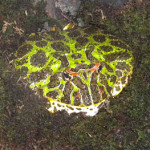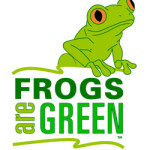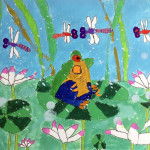On Sunday Susan and I ventured into New York City to see Frogs: A Chorus of Colors at the American Museum of Natural History, a traveling exhibit from Clyde Peeling’s Reptiland. The exhibit features over 200 live frogs in recreated natural habitats, complete with rock ledges, live plants, and waterfalls.
If you live near NYC or need an excuse to visit the Big Apple, I highly recommend this exhibit. Most of the exhibits are eye level for even the youngest kids, who had fun trying to spot the well-camouflaged frogs. They can also push buttons to hear frog calls and view videos of frogs in action.
Here are a few things we learned:
- The Cuban tree frog is probably the smallest frog at only 1/2 inch in length
- The cane toad lays 35,000 eggs in a single string
- The Australian water-holding frog digs in desert soils and can remain underground for years
- The world’s biggest frog is the West African goliath at 15 inches and weighing 7 lbs, as much as a newborn infant.
We saw a leaf mimic frog, whose head resembles a curving brown leaf to help it hide in the leaves. We saw other frogs that blended in perfectly with the moss, rocks, and bark. We watched one miniature frog, about the size of a fingernail, leaping from leaf to leaf, finally leaping and sticking on the glass right in front of Susan’s nose.
The stars of the exhibit were the poison dart frogs. Their blue, yellow, and green jewel-like colors warn predators not to eat them. One type of poison dart frog can kill 20,000 mice or 10 people with its poison, which is excreted through the skin. As the label on this exhibit says, “Don’t kiss these frogs!”




